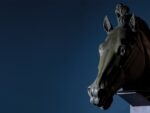Gina Folly – New Conditions
.jpg)
Mostra personale
Comunicato stampa
Text by Fabian Schöneich
Ermes-Ermes is proud to present Gina Folly’s first solo exhibition in Italy. The Swiss artist based in Basel, Switzerland, resided the last year in Rome and was influenced strongly by the city's historical breath, as well on a larger scale by the Italian traditions, customs and the to the world famous Dolce Vita.
Gina Folly’s work consists of drawings, photography, installation and sculpture. She is interested in the social phenomena of our growing wellness culture, her work adapts and transforms objects and symbols of this culture. Plants and animals as well as sounds and scents are often used within her artistic work. While us humans in a globalized world are constantly trying to be more productive,we on the other hand try to spend more time in nature or in order to save time and money at least to surround ourselves with it. The “green lifestyle boom” is critically highlighted in Folly’s work, where she negotiates the relationship between inside and outside, private and public space, both from an architectural and a social point of view. For her exhibition at Ermes-Ermes that takes place in the gallerist's private apartment in the south center of Rome, the artist presents a whole series of works done in the last nine months.
The setup is based on a work Folly realized for the first time in the beginning of the year at SALTS, an exhibition space in Basel: Magic Box. The Zoo Basel, specifically in the ape areas on the zoo, invented these polycarbonate boxes. The idea behind is simple but genius; how to simulate a natural environment for apes that never lived in freedom, that were never forced to be creative finding or getting to food. Using fingers, wood sticks or other items the apes get more and more inventive in trying to reach the food that the zoo keepers put in, out of the box. While the box itself gathers the fun factor of a termite mound for the apes, Folly is interested in the transformation that occurs by its reconstruction through humans and the abstraction of the organism due to industrial production processes. Further on, the box becomes symbolic for the entire exhibition at Ermes-Ermes. Not only it is installed on the balcony and thereby visible as the first and last intervention before entering, as well as leaving the building but also because it's standing for a space in a space, for a box in a box.
Entering the apartment by the main door, the visitors have only one way to follow. Doors to other rooms are covered with a thin layer of foil on which stretched scans of the artist's hands are printed. It feels like a
very light but strong barrier and separates the two bedrooms and the kitchen from the remaining ones.
The floor of the former living room and now main exhibition space is covered with a fluffy carpet in skin color, on which Folly placed a modernistic designed fountain. It's a handmade reproduction of an often-customized cooling device that is used by the Roman street dealers in order to keep their choice of exotic fruits and coconut pieces fresh. As a very simple gesture the installation refers to the artist’s interests of wellness culture as earlier described. We believe that exotic fruits make our life better and longer, our skin younger and our conscience purer. The fountain in Gina Folly’s exhibition becomes the center of a bigger organism, an own box in the box. As often referred to in art history the fountain itself represents the unique and always contemporary idea of youth. Cranach the Elder for example created in 1546 one of the most unique paintings referring to the classical idea of endless youth. Michelberger’s Fountain of Youth adapted the idea and creates as one of thousands of brands the ultimate drink as stated on their website: “We say: It’s the Fountain of Youth and to us it just feels like sitting under a palm tree, gazing out to the ocean, getting younger and stronger, sip by sip.” Gina Folly uses this traditional and corporate imagery their representations and products to highlight the wish of a society to be young and strong. To put a final layer on this examination the space is filled with a light scent in the air. The smell of green tea perfumes the place, which in this surrounding feels unlike home to what we see as Italian culture. On the wall, close to the floor Gina Folly shows a photograph in at 1:1 ratio of 'Ravel', a cat which spend time with her during her residency here. The cat becomes a memory and a reminder of the world we live in, a reality which is driven by our longing
for naturalness.
Gina Folly (b. 1983) lives and works in Basel. Recent solo exhibitions: in 2015 Me You 2 (with Lene Adler Petersen), Space Is The Place, Basel; Stroeme (with Mandla Reuter), S.A.L.T.S., Birsfelden; in 2014 I'll call you later, Kunsthaus Baselland, Satelitt, Basel; I want to do to you what spring does to cherry trees, Coalmine, Winterthur. Recent group exhibitions: in 2015 Summer Group Show organized by Matt Moravec & Taylor Trabulus, Germantown, NY; Cookie Gate, Ellis King, Dublin; Stipendium Vordemberge-Gildewart 2015, Kunsthaus CentrePasquArt, Biel; Performance Proletarians, Istituto Svizzero, Rome; Plattform 15, Kunstwollen, EWZ, Zurich; in 2014 How do you solve a problem like Maria?, Lola Kramers’ Apartment, Zurich; in 2013 Warum ist Landschaft shön?, Kunsthalle Basel, Basel; How to look at it?, Lecture at Elaine, Museum für Gegenwartskunst, Basel; in 2011 Multiple & Co, Villa du Parc, Annemasse, France; in 2010 The Village Cry, Kunsthalle Basel, Basel; On Publication, Portraits, Public Art an d Performance, The Modern Institute, Glasgow; Indipendent Art Fair NYC, New Jerseyy at Hard Hat, Geneva.



